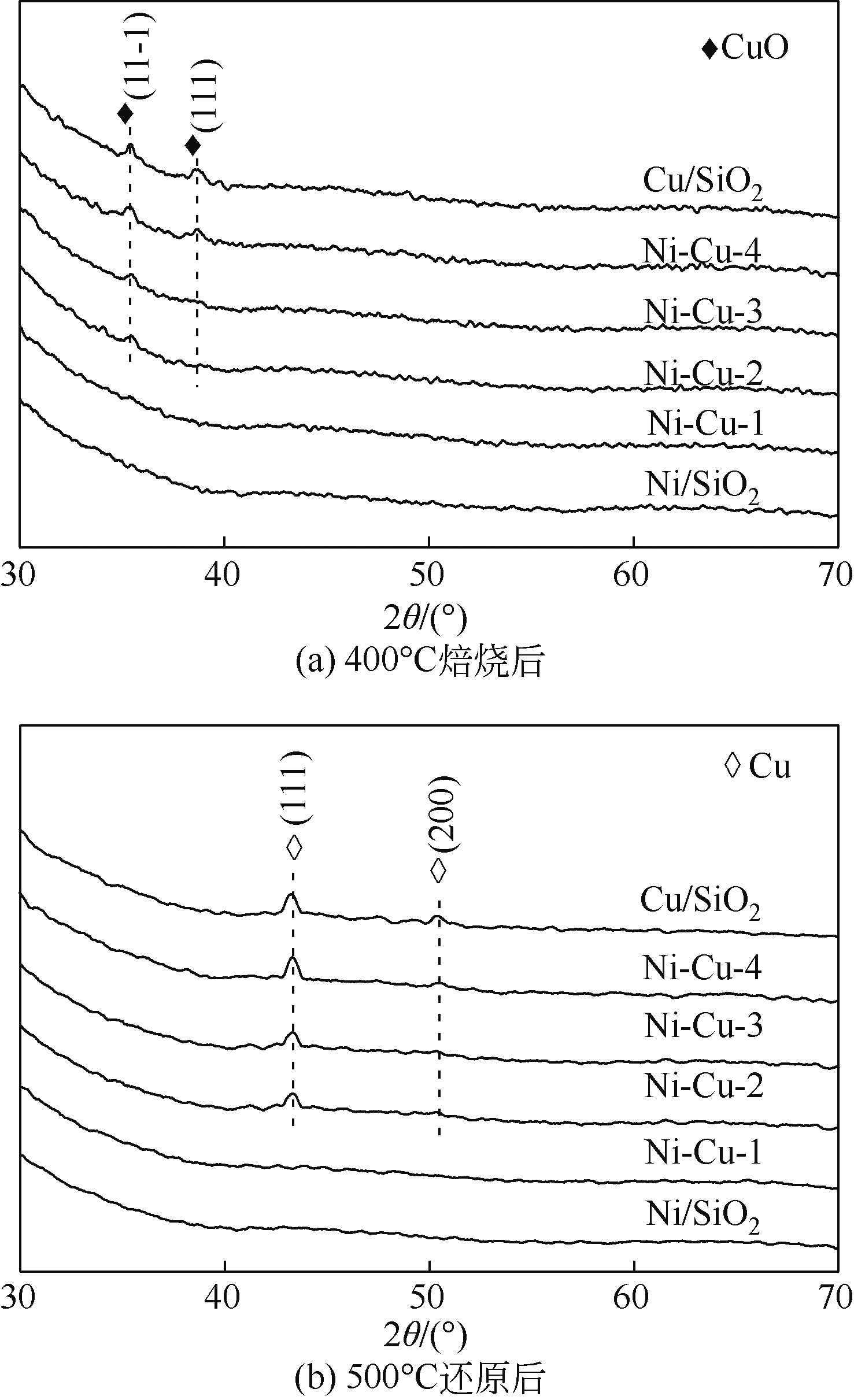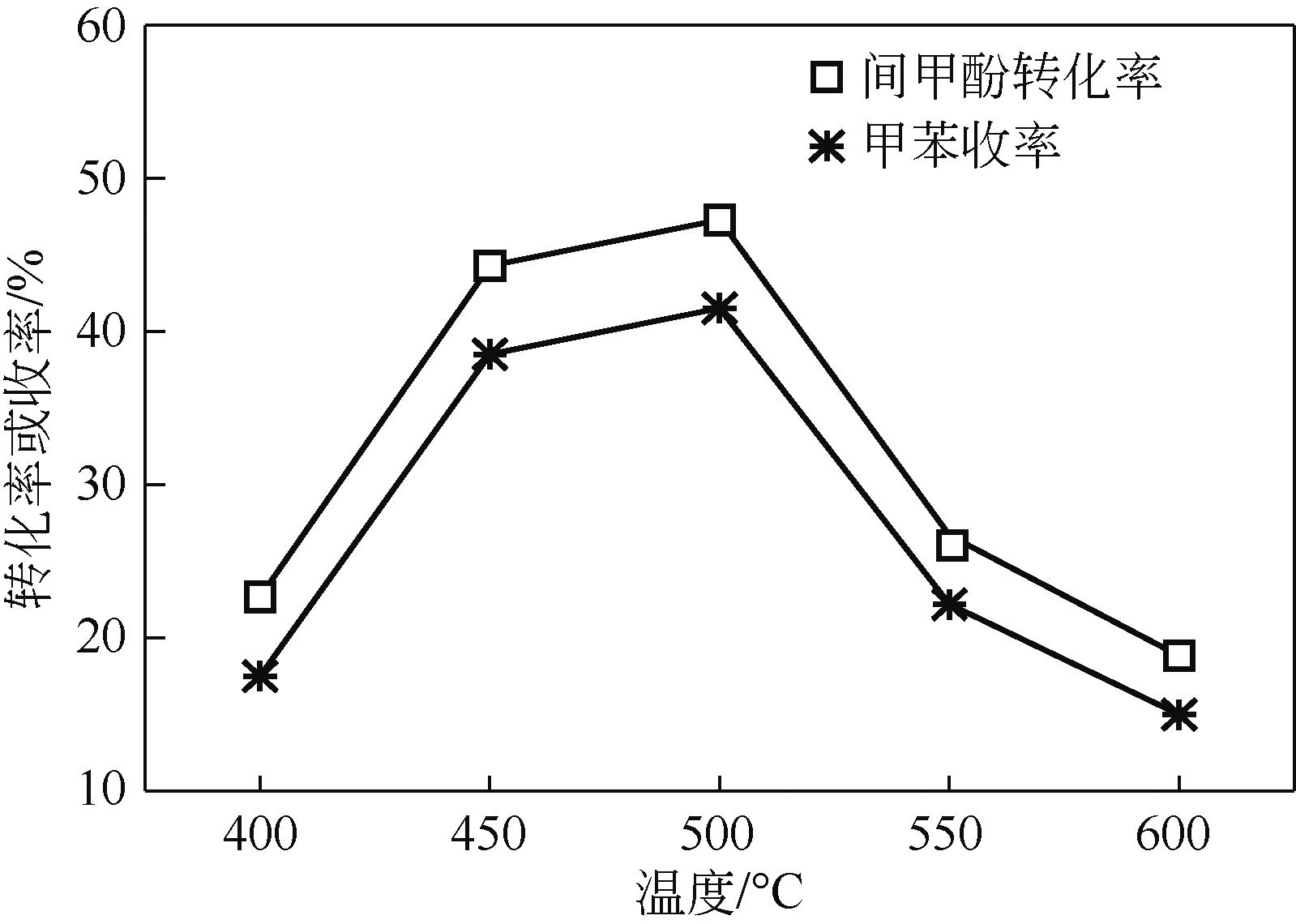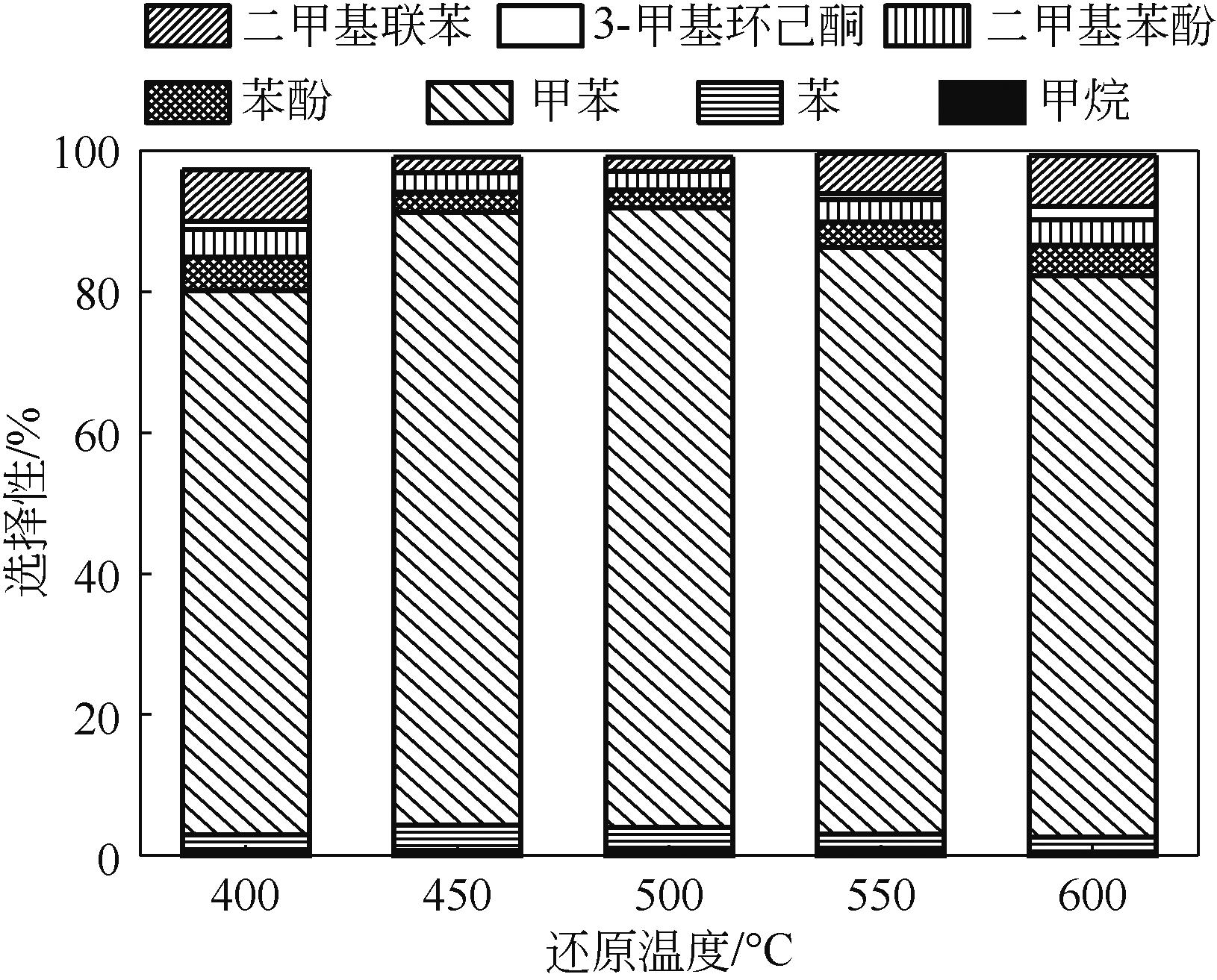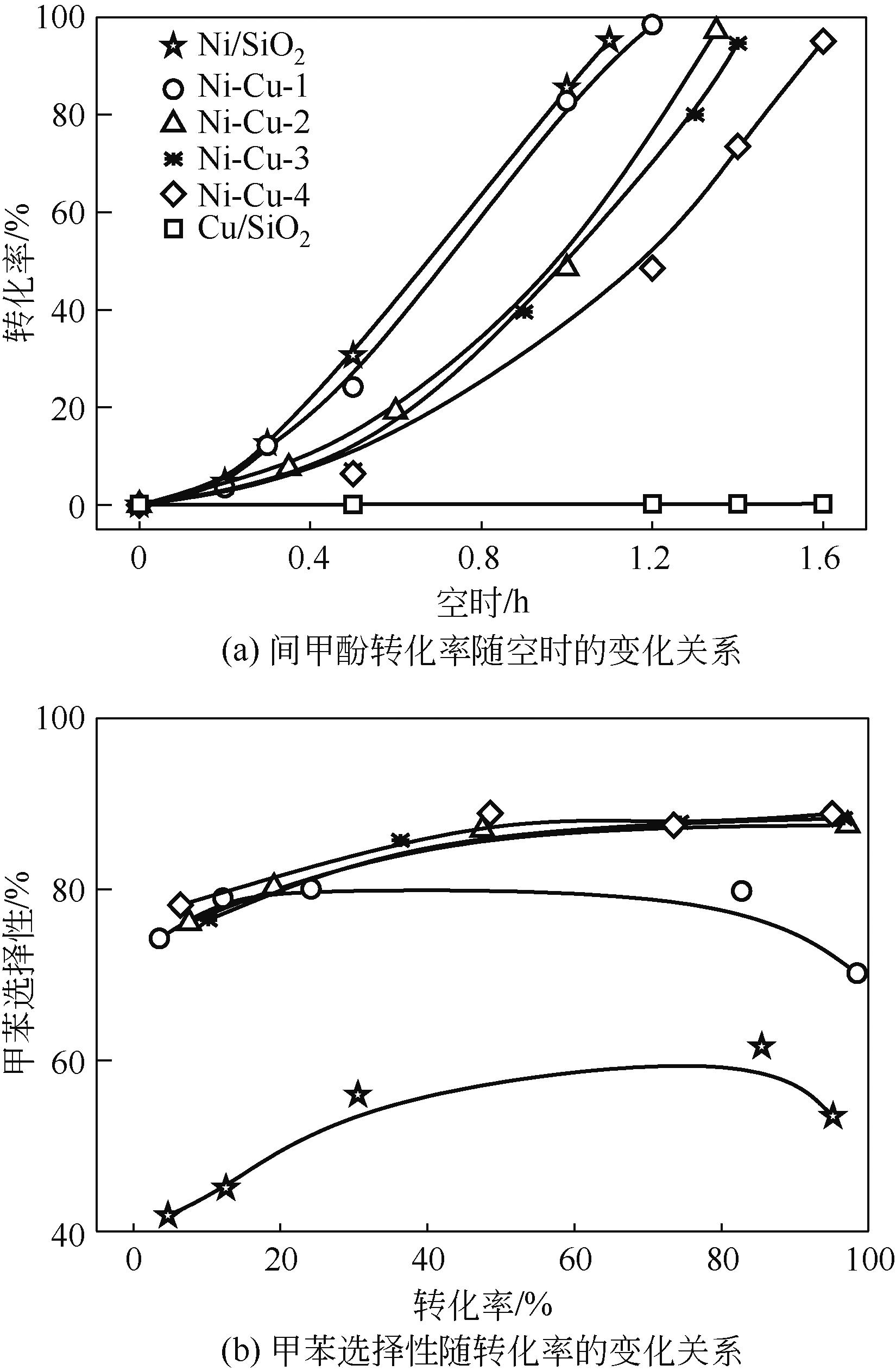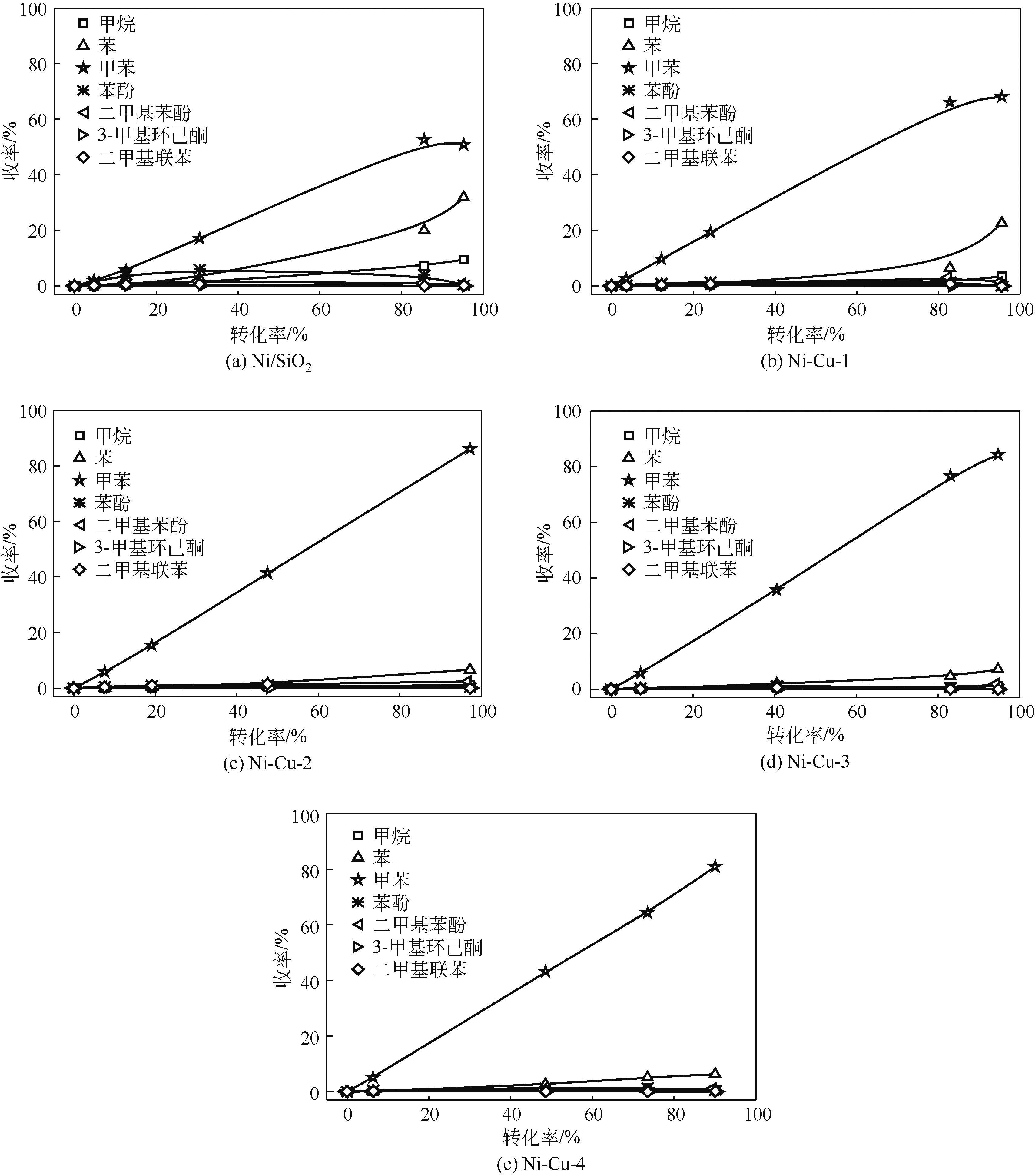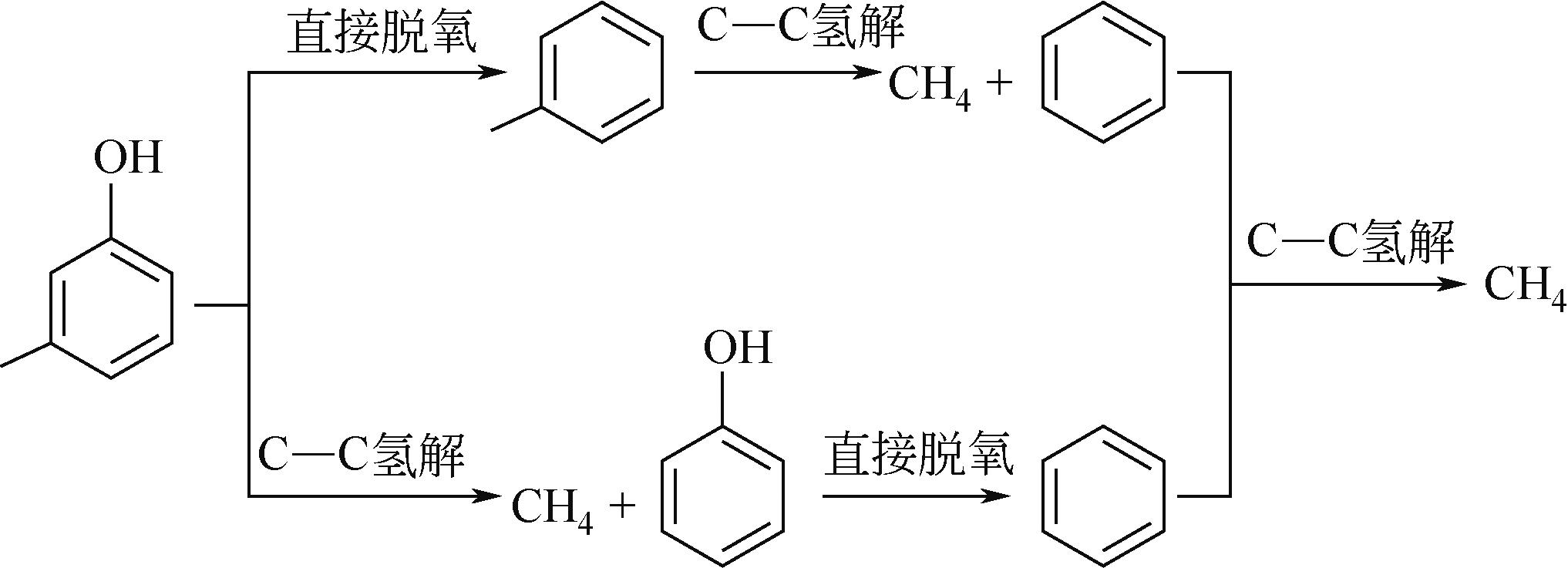化工进展 ›› 2024, Vol. 43 ›› Issue (7): 3824-3833.DOI: 10.16085/j.issn.1000-6613.2023-1009
• 工业催化 • 上一篇
溶胶-凝胶法制备高分散Ni-Cu/SiO2 促进间甲酚直接脱氧制甲苯
- 天津大学化工学院,天津 300072
-
收稿日期:2023-06-19修回日期:2023-09-14出版日期:2024-07-10发布日期:2024-08-14 -
通讯作者:祝新利 -
作者简介:王颖杰(1996—),女,硕士研究生,研究方向为酚类化合物加氢脱氧。E-mail:wangyj207@tju.edu.cn。 -
基金资助:国家自然科学基金(22278299)
Highly dispersed Ni-Cu/SiO2 synthesized by sol-gel method for prompting direct deoxygenation of m-cresol to toluene
- School of Chemical Engineering and Technology, Tianjin University, Tianjin 300072, China
-
Received:2023-06-19Revised:2023-09-14Online:2024-07-10Published:2024-08-14 -
Contact:ZHU Xinli
摘要:
在木质素生物质衍生的酚类化合物加氢脱氧生产芳烃中,Ni基催化剂兼具经济性与活性,然而,在温和条件下会受到C—C氢解的影响。在此,采用溶胶-凝胶法制备了高分散的Ni/SiO2、Cu/SiO2和不同Cu含量的双金属Ni-Cu催化剂,并在350℃和常压条件下对其进行间甲酚加氢脱氧性能测试。尽管Ni粒径约为2nm的单金属Ni/SiO2表现出高的活性和甲苯选择性,但C—C氢解生成甲烷和苯的反应仍然显著。对于双金属Ni-Cu催化剂,Ni和Cu相互作用并在还原后形成Ni-Cu合金。在最佳的双金属催化剂(Cu/Ni摩尔比约为3)上,甲苯在所有转化水平上都是主要产物。当间甲酚转化率为97.2%时,甲苯和芳烃的收率分别达到85.0%和91.6%。本征反应速率和活化能分析表明,Cu的引入通过抑制竞争性的C—C氢解反应,促进了直接脱氧生成甲苯。
中图分类号:
引用本文
王颖杰, 祝新利. 溶胶-凝胶法制备高分散Ni-Cu/SiO2 促进间甲酚直接脱氧制甲苯[J]. 化工进展, 2024, 43(7): 3824-3833.
WANG Yingjie, ZHU Xinli. Highly dispersed Ni-Cu/SiO2 synthesized by sol-gel method for prompting direct deoxygenation of m-cresol to toluene[J]. Chemical Industry and Engineering Progress, 2024, 43(7): 3824-3833.
| 样品 | 比表面积/m2·g-1 | 平均孔径/nm | Ni负载量/% | Cu负载量/% | Cu/Ni摩尔比 | H2/(Ni+Cu) |
|---|---|---|---|---|---|---|
| Ni/SiO2 | 676 | 2.94 | 1.0 | — | — | 1.00 |
| Ni-Cu-1 | 653 | 2.95 | 0.4 | 0.8 | 1.9 | 0.98 |
| Ni-Cu-2 | 565 | 2.96 | 0.3 | 1.0 | 3.1 | 1.01 |
| Ni-Cu-3 | 515 | 2.99 | 0.3 | 1.5 | 4.6 | 1.04 |
| Ni-Cu-4 | 512 | 3.06 | 0.3 | 1.9 | 5.8 | 0.95 |
| Cu/SiO2 | 557 | 2.94 | — | 1.0 | — | 0.96 |
表1 Ni/SiO2、Cu/SiO2以及双金属Ni-Cu催化剂的比表面积、平均孔径、金属负载量以及H2/(Ni+Cu)摩尔比
| 样品 | 比表面积/m2·g-1 | 平均孔径/nm | Ni负载量/% | Cu负载量/% | Cu/Ni摩尔比 | H2/(Ni+Cu) |
|---|---|---|---|---|---|---|
| Ni/SiO2 | 676 | 2.94 | 1.0 | — | — | 1.00 |
| Ni-Cu-1 | 653 | 2.95 | 0.4 | 0.8 | 1.9 | 0.98 |
| Ni-Cu-2 | 565 | 2.96 | 0.3 | 1.0 | 3.1 | 1.01 |
| Ni-Cu-3 | 515 | 2.99 | 0.3 | 1.5 | 4.6 | 1.04 |
| Ni-Cu-4 | 512 | 3.06 | 0.3 | 1.9 | 5.8 | 0.95 |
| Cu/SiO2 | 557 | 2.94 | — | 1.0 | — | 0.96 |
| 催化剂 | 反应温度 /℃ | 反应物 | 空时 /h | 转化率 /% | DDO选择性 /% | 参考 文献 |
|---|---|---|---|---|---|---|
| Ni-Ga/SiO2 | 300 | 苯甲醚 | 1 | 约70 | 约80 | [ |
| Ni-Mo/SiO2 | 350 | 间甲酚 | 0.4 | 约92 | 约92 | [ |
| Ni-Zn/SiO2 | 300 | 苯甲醚 | 0.5 | 48.6 | 89.4 | [ |
| Ni/TiO2 | 350 | 间甲酚 | 4 | 约100 | 92.2 | [ |
| Ru0.05Ce0.95O2 | 350 | 间甲酚 | 2 | 约100 | 78.2 | [ |
| Pd/ZrO2 | 300 | 苯酚 | 0.16 | 约85 | 约85 | [ |
| Pd/Nb2O5 | 300 | 苯酚 | 约0.055 | 约55 | 约76 | [ |
| Ni-Cu-2 | 350 | 间甲酚 | 1.3 | 97.2 | 94.2 | 本文 |
表2 常压条件下部分催化剂对酚类物质HDO的催化性能
| 催化剂 | 反应温度 /℃ | 反应物 | 空时 /h | 转化率 /% | DDO选择性 /% | 参考 文献 |
|---|---|---|---|---|---|---|
| Ni-Ga/SiO2 | 300 | 苯甲醚 | 1 | 约70 | 约80 | [ |
| Ni-Mo/SiO2 | 350 | 间甲酚 | 0.4 | 约92 | 约92 | [ |
| Ni-Zn/SiO2 | 300 | 苯甲醚 | 0.5 | 48.6 | 89.4 | [ |
| Ni/TiO2 | 350 | 间甲酚 | 4 | 约100 | 92.2 | [ |
| Ru0.05Ce0.95O2 | 350 | 间甲酚 | 2 | 约100 | 78.2 | [ |
| Pd/ZrO2 | 300 | 苯酚 | 0.16 | 约85 | 约85 | [ |
| Pd/Nb2O5 | 300 | 苯酚 | 约0.055 | 约55 | 约76 | [ |
| Ni-Cu-2 | 350 | 间甲酚 | 1.3 | 97.2 | 94.2 | 本文 |
| 样品 | 反应速率/μmol·g-1·min-1 | ||
|---|---|---|---|
| 间甲酚 | 甲苯 | 甲烷 | |
| Ni/SiO2 | 63.4 | 26.8 | 17.8 |
| Ni-Cu-1 | 57.2 | 43.5 | 3.8 |
| Ni-Cu-2 | 35.7 | 27.5 | 1.2 |
| Ni-Cu-3 | 22.3 | 17.6 | 0.8 |
| Ni-Cu-4 | 19.8 | 15.5 | 0.8 |
表3 Ni/SiO2和双金属Ni-Cu催化剂上间甲酚HDO的本征反应速率
| 样品 | 反应速率/μmol·g-1·min-1 | ||
|---|---|---|---|
| 间甲酚 | 甲苯 | 甲烷 | |
| Ni/SiO2 | 63.4 | 26.8 | 17.8 |
| Ni-Cu-1 | 57.2 | 43.5 | 3.8 |
| Ni-Cu-2 | 35.7 | 27.5 | 1.2 |
| Ni-Cu-3 | 22.3 | 17.6 | 0.8 |
| Ni-Cu-4 | 19.8 | 15.5 | 0.8 |
| 1 | 马隆龙, 唐志华, 汪丛伟, 等. 生物质能研究现状及未来发展策略[J]. 中国科学院院刊, 2019, 34(4): 434-442. |
| MA Longlong, TANG Zhihua, WANG Congwei, et al. Research status and future development strategy of biomass energy[J]. Bulletin of Chinese Academy of Sciences, 2019, 34(4): 434-442. | |
| 2 | CHEN Tianqi, KWON Ohhun, HUANG Renjing, et al. WO x promoted nickel catalyst for hydrodeoxygenation of m-cresol[J]. Journal of Catalysis, 2021, 400: 294-300. |
| 3 | 练彩霞, 李凝, 蒋武, 等. 生物质油催化加氢脱氧(HDO)反应机理及催化剂研究进展[J]. 化工进展, 2020, 39(S1): 153-162. |
| LIAN Caixia, LI Ning, JIANG Wu, et al. Research progress on reaction mechanism and catalysts of HDO of biomass oil[J]. Chemical Industry and Engineering Progress, 2020, 39(S1): 153-162. | |
| 4 | 陈晨, 祝新利. 苯酚类分子选择性直接脱氧制备芳烃的研究进展[J]. 化学工业与工程, 2016, 33(5): 26-32. |
| CHEN Chen, ZHU Xinli. Progress in aromatic hydrocarbons production from selective direct deoxygenation of phenolics[J]. Chemical Industry and Engineering, 2016, 33(5): 26-32. | |
| 5 | 张君涛, 武瑞瑞, 吴晓辉, 等. 酚类化合物的加氢脱氧催化剂研究进展[J]. 现代化工, 2021, 41(10): 57-62. |
| ZHANG Juntao, WU Ruirui, WU Xiaohui, et al. Research advances in hydrodeoxygenation catalysts for phenolic compounds[J]. Modern Chemical Industry, 2021, 41(10): 57-62. | |
| 6 | 李风旭, 王晓菲, 郑莹, 等. 金属助剂对Ni/SiO2催化剂苯甲醚加氢脱氧性能的影响[J]. 燃料化学学报, 2018, 46(1): 75-83. |
| LI Fengxu, WANG Xiaofei, ZHENG Ying, et al. Influence of metallic promoters on the performance of Ni/SiO2 catalyst in the hydrodeoxygenation of anisole[J]. Journal of Fuel Chemistry and Technology, 2018, 46(1): 75-83. | |
| 7 | LEE Wensheng, WANG Zhenshu, WU Ryan J, et al. Selective vapor-phase hydrodeoxygenation of anisole to benzene on molybdenum carbide catalysts[J]. Journal of Catalysis, 2014, 319: 44-53. |
| 8 | AMBURSA M M, JUAN Joon Ching, YAHAYA Y, et al. A review on catalytic hydrodeoxygenation of lignin to transportation fuels by using nickel-based catalysts[J]. Renewable and Sustainable Energy Reviews, 2021, 138: 110667. |
| 9 | CHEN Chen, CHEN Guanyi, YANG Feifei, et al. Vapor phase hydrodeoxygenation and hydrogenation of m-cresol on silica supported Ni, Pd and Pt catalysts[J]. Chemical Engineering Science, 2015, 135: 145-154. |
| 10 | 巩明月, 姜伟, 辛颖, 等. 镍基生物质油加氢脱氧催化剂的研究进展[J]. 精细石油化工, 2022, 39(3): 66-70. |
| GONG Mingyue, JIANG Wei, XIN Ying, et al. Progress on nickel based catalysts for hydrodeoxygenation of biomass oil[J]. Speciality Petrochemicals, 2022, 39(3): 66-70. | |
| 11 | CUI Beilei, WANG Hua, HAN Jinyu, et al. Crystal-phase-depended strong metal-support interactions enhancing hydrodeoxygenation of m-cresol on Ni/TiO2 catalysts[J]. Journal of Catalysis, 2022, 413: 880-890. |
| 12 | YANG Feifei, LIU Dan, ZHAO Yuntao, et al. Size dependence of vapor phase hydrodeoxygenation of m-cresol on Ni/SiO2 catalysts[J]. ACS Catalysis, 2018, 8(3): 1672-1682. |
| 13 | ZHENG Ying, ZHAO Ning, CHEN Jixiang. Enhanced direct deoxygenation of anisole to benzene on SiO2-supported Ni-Ga alloy and intermetallic compound[J]. Applied Catalysis B: Environmental, 2019, 250: 280-291. |
| 14 | WANG Xiaofei, CHEN Jixiang. Effects of indium on Ni/SiO2 catalytic performance in hydrodeoxygenation of anisole as model bio-oil compound: Suppression of benzene ring hydrogenation and C—C bond hydrogenolysis[J]. Chinese Journal of Catalysis, 2017, 38(11): 1818-1830. |
| 15 | PARK Cheol Woo, KIM Jong Wha, KIM Han Ung, et al. Bimetallic Ni-Re catalysts for the efficient hydrodeoxygenation of biomass-derived phenols[J]. International Journal of Energy Research, 2021, 45(11): 16349-16361. |
| 16 | NIE Lei, DE SOUZA P M, NORONHA F B, et al. Selective conversion of m-cresol to toluene over bimetallic Ni-Fe catalysts[J]. Journal of Molecular Catalysis A: Chemical, 2014, 388/389: 47-55. |
| 17 | WANG Dandan, GU Xiaoyu, SHI Haonan, et al. Effect of Zn on performance of Ni/SiO2 for hydrodeoxygenation of anisole[J]. Journal of Fuel Chemistry and Technology, 2022, 50(10): 1341-1349. |
| 18 | HE Han, XIA Shuqian, LUO Dan. Sn-assisted nickel synergistically catalyzes the direct cleavage of CAr—O bond in lignin-derived m-cresol: Theoretical and experimental analysis[J]. Journal of Catalysis, 2022, 410: 180-193. |
| 19 | WU Xiaoxia, GE Qingfeng, ZHU Xinli. Vapor phase hydrodeoxygenation of phenolic compounds on group 10 metal-based catalysts: Reaction mechanism and product selectivity control[J]. Catalysis Today, 2021, 365: 143-161. |
| 20 | YANG Feifei, KOMARNENI M R, LIBRETTO N J, et al. Elucidating the structure of bimetallic NiW/SiO2 catalysts and its consequences on selective deoxygenation of m-cresol to toluene[J]. ACS Catalysis, 2021, 11(5): 2935-2948. |
| 21 | CADENHEAD D A, MASSE N G. The microcatalytic hydrogenation of benzene over groups Ⅷ and Ⅰb metals and alloys[J]. The Journal of Physical Chemistry, 1966, 70(11): 3558-3566. |
| 22 | GANDARIAS I, REQUIES J, ARIAS P L, et al. Liquid-phase glycerol hydrogenolysis by formic acid over Ni-Cu/Al2O3 catalysts[J]. Journal of Catalysis, 2012, 290: 79-89. |
| 23 | NESTEROV N S, SMIRNOV A A, PAKHARUKOVA V P, et al. Advanced green approaches for the synthesis of NiCu-containing catalysts for the hydrodeoxygenation of anisole[J]. Catalysis Today, 2021, 379: 262-271. |
| 24 | IBRAHIM A, LIU Xin, UGUNA C N, et al. Hydrodeoxygenation of p-cresol over CuNi@C catalyst derived from metal-organic frameworks precursor[J]. Fuel, 2022, 329: 125320. |
| 25 | BYKOVA M V, D Yu ERMAKOV, KAICHEV V V, et al. Ni-based sol-gel catalysts as promising systems for crude bio-oil upgrading: Guaiacol hydrodeoxygenation study[J]. Applied Catalysis B: Environmental, 2012, 113/114: 296-307. |
| 26 | 简雅婷, 余强, 陈小燕, 等. 木质素制备生物液体燃料进展[J]. 化工进展, 2021, 40(S2): 109-116. |
| JIAN Yating, YU Qiang, CHEN Xiaoyan, et al. Progress in the preparation of liquid biofuels from lignin[J]. Chemical Industry and Engineering Progress, 2021, 40(S2): 109-116. | |
| 27 | NIU Xiongxiong, WANG Liwen, CHEN Jixiang. Improved performance of SiO2-supported Ni3Ga intermetallic compound for deoxygenation of phenolic compounds[J]. Catalysis Communications, 2020, 140: 106001. |
| 28 | FU Desen, WU Xiaoxia, CUI Beilei, et al. Ru0.05Ce0.95O2 solid solution derived Ru catalyst enables selective hydrodeoxygenation of m-cresol to toluene[J]. ChemCatChem, 2021, 13(22): 4814-4823. |
| 29 | 付金萍, 赵洋, 周强, 等. 草酸二甲酯气相法加氢制乙二醇催化剂研究进展[J]. 工业催化, 2014, 22(10): 736-746. |
| FU Jinping, ZHAO Yang, ZHOU Qiang, et al. Research progress in the catalysts for vapor phase hydrogenation of dimethyl oxalate to ethylene glycol[J]. Industrial Catalysis, 2014, 22(10): 736-746. | |
| 30 | ZHANG Xinghua, WANG Tiejun, MA Longlong, et al. Characterization and catalytic properties of Ni and NiCu catalysts supported on ZrO2-SiO2 for guaiacol hydrodeoxygenation[J]. Catalysis Communications, 2013, 33: 15-19. |
| 31 | ZHU Tianhan, SONG Hua, LI Feng, et al. Preparation of NiCu alloy catalyst for the hydrodeoxygenation of benzofuran[J]. Catalysis Letters, 2021, 151(6): 1670-1682. |
| 32 | WANG Xiaotong, YU Zhihao, YE Lei, et al. Layered double hydroxide-derived bimetallic Ni-Cu catalysts prompted the efficient conversion of γ-valerolactone to 2-methyltetrahydrofuran[J]. ChemCatChem, 2022, 14(1): e202101441. |
| 33 | YANG Feifei, LIBRETTO N J, M Rao KOMARNENI, et al. Enhancement of m-cresol hydrodeoxygenation selectivity on Ni catalysts by surface decoration of MoO x species[J]. ACS Catalysis, 2019, 9(9): 7791-7800. |
| 34 | TELES C A, DE SOUZA P M, BRAGA A H, et al. The role of defect sites and oxophilicity of the support on the phenol hydrodeoxygenation reaction[J]. Applied Catalysis B: Environmental, 2019, 249: 292-305. |
| 35 | BARRIOS A M, TELES C A, DE SOUZA P M, et al. Hydrodeoxygenation of phenol over niobia supported Pd catalyst[J]. Catalysis Today, 2018, 302: 115-124. |
| [1] | 刘文津, 张玉明, 李家州, 张炜, 陈哲文. 典型石油热加工技术发展现状及展望[J]. 化工进展, 2024, 43(7): 3534-3550. |
| [2] | 张子杭, 王树荣. 生物质热解转化与产物低碳利用研究进展[J]. 化工进展, 2024, 43(7): 3692-3708. |
| [3] | 龚德成, 沈倩, 朱贤青, 黄云, 夏奡, 张敬苗, 朱恂, 廖强. 微藻超临界水气化制取富氢合成气的研究进展[J]. 化工进展, 2024, 43(7): 3709-3728. |
| [4] | 郭鹏, 李红伟, 李贵贤, 季东, 王东亮, 赵新红. 直接甲醇燃料电池阳极催化剂的失活机制及应对策略[J]. 化工进展, 2024, 43(7): 3812-3823. |
| [5] | 蓝瑞嵩, 刘丽华, 张倩, 陈博彦, 洪俊明. 硫掺杂石墨烯作为MFC阴极性能和生物毒性检测[J]. 化工进展, 2024, 43(6): 3430-3439. |
| [6] | 朱连燕, 周幸福. 锰掺杂DSA电极及其对印染废水处理的过程优化[J]. 化工进展, 2024, 43(6): 3459-3467. |
| [7] | 何世坤, 张文豪, 冯君锋, 潘晖. 负载金属型固体酸催化木质纤维生物质定向转化为乙酰丙酸甲酯[J]. 化工进展, 2024, 43(6): 3042-3050. |
| [8] | 陈富强, 仲兆平, 戚仁志. 铜基催化剂电还原二氧化碳为甲酸研究进展[J]. 化工进展, 2024, 43(6): 3051-3060. |
| [9] | 曾壮, 李柯志, 苑志伟, 杜金涛, 李卓师, 王悦. CO/CO2 加氢制低碳醇改性费托合成催化剂研究进展[J]. 化工进展, 2024, 43(6): 3061-3079. |
| [10] | 冯占雄, 张创, 刘德政, 汪云, 马强, 王诚. 不同气氛热处理对连续管道微波技术制备Pt/C催化剂氧还原性能的影响[J]. 化工进展, 2024, 43(6): 3080-3092. |
| [11] | 周皞, 王旭瑞, 赵辉爽, 温妮妮, 苏亚欣. CuCe-SAPO-34选择性催化丙烯还原柴油车尾气氮氧化物[J]. 化工进展, 2024, 43(6): 3093-3099. |
| [12] | 蔚德磊, 韩康顺, 陈瑶, 刘祥春, 崔平. 单原子Ni、N共掺杂碳材料基催化剂电还原CO2制CO研究进展[J]. 化工进展, 2024, 43(6): 3174-3186. |
| [13] | 龚雪梅, 蒋军, 王超, 梅长彤. 纳米纤维素疏水改性及其功能化应用研究进展[J]. 化工进展, 2024, 43(6): 3187-3198. |
| [14] | 万成凤, 李志达, 张春月, 路璐. MXene负载CoP纳米棒高效电催化分解水制氢[J]. 化工进展, 2024, 43(6): 3232-3239. |
| [15] | 肖自胜, 李金玲, 陈伊睿, 兰支利, 尹笃林. g-C3N4锚定Cu(Ⅰ)高选择性催化CCl4合成2,4,4,4-四氯丁腈[J]. 化工进展, 2024, 43(6): 3293-3300. |
| 阅读次数 | ||||||
|
全文 |
|
|||||
|
摘要 |
|
|||||

